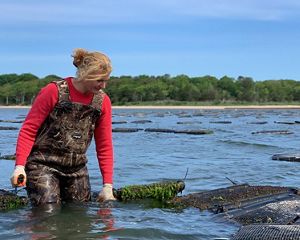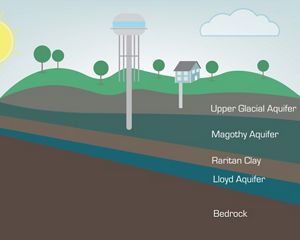Shelter Island was originally inhabited by the Manhansets, Native Americans who were part of the widespread Algonquin culture. In 1653 Chief Pogatticut, sachem or “chief” of the Manhansets, deeded all of Shelter Island to Nathaniel Sylvester. Sylvester, a sugar merchant from Barbados, established a Quaker refuge on the island.
In 1693, Giles Sylvester, Nathaniel's son, sold Mashomack to William Nicoll I, starting a tradition of the Nicoll family at Mashomack. The Nicolls were early settlers in the Islip area. What is now known as Mashomack was originally called Sachem’s Neck (the main body of the preserve) and Mashomack referred only to Mashomack Point. Mashomack means “where they go by water,” and the point was probably an island before a narrow neck formed, connecting it to the rest of the peninsula.
William Nicoll II was the first full-time resident of Mashomack. William II deeded Mashomack to William III, who farmed the land with his family. Over the years the property was divided among members of the Nicoll family. Turn-of-the-century notable Nicolls include “Miss Annie” Nicoll, who farmed the still-open fields in the center of the preserve. Dr. Sam Nicoll, her brother, built the Bass Creek Cottage now known as the Manor House.
By 1908, nonresident Nicoll heirs had begun selling their portions of Mashomack. F.M. Smith (of 20 Mule Borax fame) was one of the buyers and may have built the building now used as the Visitor Center.
In 1925 Otto Kahn, a wealthy German financier, bought Nicoll family holdings and other portions that had been previously sold, reestablishing the integrity of the tract for a real estate investment. Fortunately, due to the Stock Market Crash of 1929, his development plan never materialized.
In 1934, the Gerard real estate combine purchased Mashomack from Kahn’s estate. The property was leased to several fish and game clubs. Of the hunt clubs which have used the Mashomack property over the years, the most well remembered is the Mashomack Fish and Game Club. Most members were wealthy Long Island or New York City folks who joined the club to hunt pheasant, duck or deer. An occasional fox hunt, complete with hounds and horses, was also held. The two fields in the center of the preserve were converted into a skeet range and tennis court. The well-appointed Manor House served as the Lodge. During the club’s residence, a design emerged to develop Mashomack into an exclusive housing area. A golf course, marina and beautiful waterfront homes were planned, and investors for the project were secured. The development scheme folded in 1979.
It was at this point that The Nature Conservancy stepped in and secured Mashomack. Since the 1950s, TNC had expressed hopes of preserving Mashomack because of its population of the then-state-endangered osprey and rare plants. The Gerard family (Aeon Realty) and The Nature Conservancy came to an agreement in 1979.
On January 14, 1980, The Nature Conservancy took title to Mashomack with the support of 1,700 Shelter Islanders and Nature Conservancy members, foundations and corporations nationwide.
For more details on Mashomack’s history, see Muriel Porter Weaver’s book, Where They Go By Water, available in the Manor House library.














